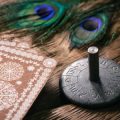Roots Amidst the Mists: Ancient Druidic Divination
Long before the hum of modernity swept across Britain’s rolling hills, an ancient wisdom pulsed quietly beneath the emerald canopies and stone circles. Druidic divination—once the sacred art of seers, poets, and priestesses—emerged from the very soul of Celtic Britain. In those mist-shrouded times, divination was more than a means to glimpse the future; it was a living dialogue between humanity and the land itself. The Druids, revered as intermediaries between worlds, drew upon intuitive insight, natural omens, and ritual to guide chieftains, communities, and the turning of the seasons.
This practice was steeped in reverence for rivers, groves, and ancient yews—a recognition that every whispering wind or circling raven might carry messages from the Otherworld. The bond between seer and sacred earth was woven through story, song, and ritual firelight. As we explore the decline and revival of this tradition in modern Britain, we must first listen for those ancestral echoes: the pulse of intuition that once guided a people whose fate was inseparable from the wild spirit of their land.
2. Shadows Fall: Suppression and Decline
The echoes of Druidic divination once reverberated through Britain’s ancient groves, but as the mists of time shifted, shadows began to fall upon these sacred traditions. The arrival of Christianity, with its structured doctrine and powerful institutions, marked the first turning point in the gradual suppression of Druidic practices. The old ways—woven into the landscape and psyche of Celtic peoples—were increasingly viewed as heretical or even dangerous by ecclesiastical authorities seeking to unify spiritual life under a single faith.
Legal restrictions soon followed spiritual condemnation. The British monarchy and Parliament passed statutes that criminalised “witchcraft,” “sorcery,” and any form of pagan ritual, often lumping Druidic divination together with other indigenous magical arts. These laws were not merely symbolic; they carried severe penalties, including imprisonment or worse, which led to the forced secrecy or abandonment of many ancestral practices. Communities who once gathered openly for seasonal rites found themselves relegated to the margins, their wisdom whispered only in trusted circles or hidden within local folklore.
Cultural shifts accelerated this decline further. As Britain urbanised and modernised through the centuries, reverence for nature’s cycles—a cornerstone of Druidic insight—waned. New generations grew up under different rhythms: factory whistles replaced birdsong, and scientific rationalism overshadowed intuitive communion with land and spirit. What was once living knowledge slowly faded into quaint superstition or mythic memory.
Key Factors in the Suppression of Druidic Divination
Era |
Forces at Work |
Impact on Druidic Practice |
|---|---|---|
| Christianisation (5th–11th centuries) |
Ecclesiastical opposition Sermons against “paganism” |
Demonisation of rituals Loss of public ceremonies |
| Legal Restrictions (16th–18th centuries) |
Witchcraft Acts Punitive legislation |
Criminalisation Secrecy or cessation of practices |
| Cultural Shifts (19th–20th centuries) |
Industrialisation Scientific worldview |
Erosion of oral tradition Marginalisation as folklore |
This long twilight saw much ancient wisdom slip quietly into obscurity, preserved only in fragments—stories told by firesides, symbols etched on standing stones, or customs woven into rural festivals. Yet even as the world changed around them, something ineffable remained—a faint ember waiting for new breath.

3. Whispers Through the Veil: Folk Memory and Survival
Even as the great oak groves fell silent and Druidic assemblies faded from public record, the ancient arts of divination did not vanish entirely from Britain’s mist-laden landscape. Instead, these sacred practices retreated—like whispered secrets—into the heart of rural communities, woven into everyday life through custom, story, and superstition.
Across the rolling hills of Wales, the rugged moors of Cornwall, and the emerald hedgerows of Somerset, fragments of Druidic wisdom survived in local lore. Village folk would gather at twilight beneath ancient yews or at holy wells, seeking omens in the flight of birds, the swirling mists, or the peculiar behaviour of livestock. These acts—at once ordinary and enchanted—echoed age-old rites that once shaped destinies and crowned kings.
The Language of Signs
In many a hamlet, farmers and wise women kept alive the language of signs. The crackle of a hearth fire or the sudden silence before a storm were read as messages from realms unseen. Some say that “watchers on the threshold”—elders with a gift for sight—would interpret dreams or cast lots with hazel twigs, their actions echoing the seers who once stood within sacred stone circles.
Cunning Folk and Hedge Wisdom
Throughout centuries when open Druidry was proscribed or derided, cunning folk became keepers of tradition. These figures—part healer, part oracle—were sought after for charms to protect crops or love potions brewed by moonlight. Their knowledge carried traces of Druidic insight: an understanding that all things are interconnected and that fate might be glimpsed through nature’s subtle cues.
The Quiet Persistence of Mystery
Though authorities often dismissed such beliefs as mere superstition, these customs persisted stubbornly in Britain’s cultural tapestry. They offered comfort in uncertain times—a way to seek guidance when rational answers failed. Each tale shared beside a peat fire or each ritual performed at dawn was another thread binding modern life to ancient wonder—a soft but enduring whisper through the veil separating worlds.
4. A Stirring in the Greenwood: Modern Revival Movements
After centuries of slumber, like the ancient oaks themselves, Druidic divination has begun to stir once more in the greenwood of modern Britain. The 20th century saw a quiet yet profound reawakening, as those sensitive to the subtle whispers of the land sought to reconnect with ancestral wisdom. This revival was neither accidental nor isolated; rather, it emerged from a confluence of spiritual yearning and cultural rediscovery, finding fertile ground among poets, scholars, and seekers disenchanted with the mechanistic world.
Roots of Reawakening: The Early Revivalists
In the aftermath of two World Wars, a longing for meaning and belonging drew individuals to Britain’s mythic past. Groups such as the Ancient Order of Druids and later the Order of Bards, Ovates and Druids (OBOD) took up the mantle, blending historical research with intuitive practice. These early revivalists gathered at sacred sites—Stonehenge, Avebury, Glastonbury Tor—conducting ceremonies that honoured earth, sky, and spirit. Their approach was not mere reenactment but imaginative reconstruction: weaving together fragments from folklore, classical sources, and personal revelation.
Contemporary Seekers and New Communities
The late 20th and early 21st centuries witnessed an efflorescence of Druidic groups across Britain. Many found their way through environmental activism or neo-pagan circles, while others were drawn by an unnameable pull—a sense that the old ways might offer guidance for a fractured age. Today’s practitioners are as likely to be found in urban meditation spaces as in rural groves, united by a reverence for nature’s cycles and a desire for direct spiritual experience.
Druidic Revival: Key Movements and Focus Areas
| Movement/Group | Era Founded | Main Focus | Cultural Impact |
|---|---|---|---|
| Ancient Order of Druids (AOD) | 1781 (revitalised 20th c.) | Fraternal organisation; ritual and fellowship | Popularised public ceremonies; fostered community |
| Order of Bards, Ovates & Druids (OBOD) | 1964 | Spiritual exploration; divination; bardic arts | Influential on global neo-Druidry; educational resources |
| The Druid Network | 2003 | Nature spirituality; advocacy; education | Legal recognition as a religion in UK (2010) |
| Druid Camp Gatherings | 1990s-present | Ceremony; community-building; experiential learning | Brought together diverse seekers; celebrated seasonal rites |
A Living Tradition Reborn
This reawakening is marked not by dogma but by dialogue—with history, with myth, with land and lineage. Divinatory practices are being rediscovered through ogham staves carved from local wood, meditations inspired by the movements of sun and moon, and rituals shaped by both ancient lore and modern intuition. In glades at dawn or beneath city skies at dusk, Britons are once again listening for signs—a feather on the path, a whisper in the wind—trusting that spirit still speaks through the living greenwood.
5. Sacred Tools, New Stories: Contemporary Practices and Challenges
Modern British Druids find themselves standing at a crossroads between the echoes of ancient groves and the demands of a rapidly evolving society. The sacred tools of their forebears—ogham staves carved from yew or ash, intricately woven wands, and the ever-mysterious cauldron—are not simply relics for display. Instead, they are lovingly reimagined and infused with fresh meaning, serving as bridges that connect the timeless wisdom of the land with the living spirit of today’s Britain.
Honouring Tradition in Everyday Life
For contemporary practitioners, the act of divination is no longer hidden in oak-shadowed secrecy but woven into daily rituals. Some gather beneath city trees with pocket ogham sets; others adapt the reading of animal omens to suburban foxes and urban crows. The stories once whispered by bards around ancient fires now find new life in community gatherings, online circles, and podcasts—each retelling shaped by the voice of modern Britain while still reverent to its mythic roots.
Reimagining Sacred Tools
The revival has inspired innovation. Crystal pendulums may sit beside traditional staff and stone; tarot decks reflecting British flora and fauna nestle alongside hand-carved runes. These adaptations are not mere novelty—they express a desire to make Druidic divination accessible, relevant, and intimately connected to place. A single feather found on a city street can become an oracle, just as potent as those found in ancient woodland.
Navigating Authenticity and Innovation
This creative resurgence does not come without tension. Within Druid circles, questions arise: How much can we adapt before tradition loses its essence? Can new myths carry the same weight as old ones? As Druids share their practices on social media or lead public ceremonies at sacred sites like Stonehenge and Avebury, there is an ongoing dance between preserving authenticity and embracing inclusivity—a challenge both daunting and exhilarating.
The Living Lore of Modern Britain
Through these evolving practices, modern British Druids craft new stories rooted in ancestral soil but blossoming towards unknown futures. Their divinatory work is not about predicting fates set in stone but listening deeply—to landscape, lineage, and inner calling—so that each generation may walk their own path through mystery with courage, creativity, and respect for all that has come before.
6. Circle of Wisdom: Druids and British Identity Today
As dawn breaks over the ancient stone circles and misty woodlands of Britain, a quiet resurgence is unfolding—one that gently entwines the wisdom of Druidic divination with the rhythms of modern life. The role of Druidic practices, once nearly lost to time, is now blossoming into a living thread within the fabric of British identity.
The Personal Pilgrimage
For many seekers, Druidic divination serves as both mirror and compass. Through casting ogham sticks or meditating beneath age-old yews, individuals are invited to explore their own stories—unearthing ancestral echoes while nurturing intuition. This personal journey becomes an act of reclamation, a way to weave the magic of old into everyday existence, grounding oneself amidst the uncertainties of contemporary society.
The Collective Hearth
Yet, this revival is not merely solitary. Across Britain, circles gather in sacred groves and urban parks alike, rekindling the communal spirit that has long defined Druidry. Here, divination rituals foster a sense of belonging—a shared language spoken through symbols, myth, and reverence for the land. These gatherings create a sacred space where past and present merge, strengthening the bonds between people and place.
Bridging Heritage and Renewal
Druidic divination offers more than nostalgia; it acts as a bridge between heritage and spiritual renewal. In a world often marked by fragmentation, these traditions remind Britons of their deep-rooted connection to nature and story. By honouring ancient cycles and listening to intuitive guidance, practitioners find inspiration for living in harmony with both tradition and transformation.
A Living Legacy
Ultimately, the circle of wisdom spun by modern Druids is dynamic—ever-evolving yet deeply anchored in the soul-soil of Britain. Whether whispered through oracle cards or sung in seasonal rites, Druidic divination shapes identity not as a relic but as a living inheritance. It invites each generation to step into the dance between memory and mystery, carrying forward a flame that lights the way home—to themselves and to their land.


